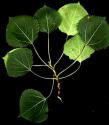

Aspen (Populus spp, P. tremuloides, P. candicans, P. balsamifera)
Folk Names: Aspen Poplar, Cottonwood, European Aspen, Lombardy Poplar, Mountain Aspen, Necklace Poplar, Quiver Leaf, Trembling Poplar, White Poplar; (P tremuloides) White Poplar, American Aspen, Quaking Apsen; (P candicans) Balm-bud, Balm of Gilead, Balsam Poplar; (P balsamifera) Balsam-poplar, Carolina Poplar, Tacamahac
Description: The thirty-five species of aspen or poplar are a members of the willow family. It will grow in any area but swamps, and can be found from Newfoundland west to Alaska, and south to Virginia, Kentucky, Iowa, and the mountain areas as far south as west Mexico. Aspen will generally grow from thirty to forty feet up to one hundred feet. The bark is whitish and smooth in young trees, turning brown and rough near the base in older trees. The finely toothed leaves are alternate and ovate to orbicular on very thin, flattened petioles. They are usually a darker shade of green above than below. Slender male and female catkins appear starting in April or May on separate trees, a month before the leaves. The fruits are one-celled capsules of numerous seeds with long tufts of silky hair.
The winter buds of P. candicans are large, resinous, and aromatic. The young twigs are sparsely hairy, and the broadly ovate to deltoid leaves are sometimes hairy on the lower veins.
The P. balsamifera grows from fifty to seventy feet with a trunk about eighteen inches in diameter. The branches are smooth and deep brown. The buds have a pleasant, incense-like smell and a bitter taste.
The young bark of P. tremuloides is a pale yellowish color. The bark may be collected in the spring. It has a bitter taste, but no odor.
Effects: strong; (P. tremuloides) gentle
Planet: Venus; (P. tremuloides) Saturn Zodiac: Capricorn
Element: Air; (P. tremuloides) Water
Associated Deities: Dryope, Hercules, Leuce, Phaeton
Traditions:
Aspen is one of the traditional stakes used for vampires.
According to Greek legend, aspens were created from the Heliades, the three grief stricken sisters of Phaeton. They witnessed their brother's fall from the skies into River Eridanus when he failed to drive the Sun Chariot, and wept unceasingly into the river until they turned into poplar aspen trees. Their tears, which continued to leak through bark, were turned to amber by the god Helios. Leuce a lovely young nymph, loved by Hades, was also changed to an aspen after her death.
Apollo seduced the shepherdess Dryope as a tortoise. When she held it close to her breast, he transformed into a snake. Later she gave birth to a son who built a temple in his father's honor. Whenever she visited, her presence was memorialized by a poplar.
The aspen tree is also dedicated to Herakles who wore a crown of the leaves to retrieve Cerberus. This is why leaves are a darker green on top- from exposure to the smoky fumes of Hades. For this reason, it was a Greek tree symbolic of heroism.
Magic:
Use aspen in anti-theft spells, and plant it in your garden as a defense from thieves. It is said the leaf, placed under the tongue, will enhance one's eloquence.
The buds and leaves of P. tremuloides may be carried to attract money and added to incense for the same. It is also said to be a constituent of the famous "flying ointment" and may be used in spells to achieve astral projection.
Known Combinations:
none noted
Medical Indications: Parts Used: buds, outer bark
Though both P. tremuloides and P. candicans may be used to similar effect, P. balsamifera is considered the superior species in medical terms. The inner bark of all aspen may be used as quinine, with less of an after-effect. Aspens have been used to treat headaches caused by liver or stomach conditions of flatulence and acidity. They have also been used to treat faintness, hysteria, neuralgia, diabetes, hay fever, cholera, and infant diarrhea.
The bark and leaves of all aspen may be simmered as a cleansing wash for cuts, wounds, skin cancer, ulcers, eczema, burns, and sore arms and legs. It is also an excellent tonic and conditioning wash for healthy skin, used once a week. The slightly sticky winter buds were used in tea for external and internal use, and soothing salve is produced if the buds are boiled in olive oil. The tea is excellent for sore throat.
P. tremuloides is a balsamic, febrifuge, diuretic, and tonic. The bark is useful for fever and flu symptoms, and may be prepared as a tea. The tea also aids digestion. The Cree and Delaware boiled bark for cough medicine, and the Delaware also boiled the root for tonic. The Mohawk made a bark tea to expel worms, and the Fox Indians boiled buds in fat as a salve for noses sore from the cold. The Chippewa made use of aspen as a heart medicine, used an infusion of the root to prevent premature birth, and chewed the bark into a poultice for cuts.
P. candicans is also a balsamic, as well as an expectorant and stimulant. The buds are used in the same fashion as P. tremuloides. The tea may also be used as an inhalant for congestion.
Nutrition:
Some Native American tribes ate the inner bark of P. tremuloides or made it into syrup for a tonic. It was also dried and powdered as flour additive to make it stretch further.
Mercantile Uses:
The wood of aspens is used for crates and matches, and to make magazine pulp. It is a useful tree for reforestation.